I have been interested in ART since I first heard of it. I went through the Module 1 training day over a year ago and relatively recently was able to be signed-off as completed. I had wanted to attend the Module 2 training and have pushed towards plain bob minor quarter peals with my best attempt getting to 760 changes before I lost the plot. It seemed like being a full member of ART was beyond my grasp. Apparently my situation was not by any means unique! ART split M2 into two approaches. M2F (foundation skills – teaching call changes through to plain hunt) and M2C (change ringing – teaching up to plain bob minor).
The M2F course had only run once before, at the time of writing this, I had to travel 90 miles to get to Marsworth from Cambridgeshire for my progression in ART.
This M2F training was hosted by Richard Booth representing All Saints Church (the 6-bell tower in Marsworth) with the session run by Paul Lewis. He was ably supported by Gill Hughes and Rose Nightingale as observers (Yes! Rose is a real person!).
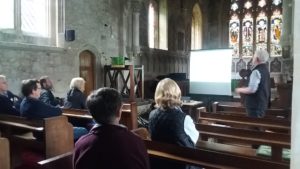
Powerpoint Presentation in the Church
The introductions (which I always find interesting) showed that all the training participants were ‘teachers’ rather than ‘mentors’. I am always intrigued by why people attend such trainings. The reasons given were ‘I was elected’ and ‘I needed to’ etc. My introduction included the simple fact that most people at my tower can ring better than me however I needed to be able to train fewer learners without relying too heavily on others’.
With the introductions over we revisited the need to ensure that our learner’s foundation skills were solid. There were some interesting practical exercises carried out, as always, including those to build skills incrementally such as standing on backstroke and getting the learner move up and down the tail/sally to aid bell control. The practical exercises are probably well known but how many of us design exercises where there is little physical movement of the rope involved in the objective? What about listening to where their bell is or, even more interesting, designing exercises to build confidence rather than bell control?
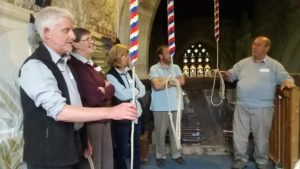
Group discussion – sharing ideas
After coffee & biscuits we returned to the tower to talk through ‘teaching call changes’. The question was asked about calling UP or calling DOWN (or regional variations of ‘2 and 3’ or ‘2 over 3’ etc.) without any real preference about the best way except to never mix them up! We had a discussion about the later problems in learners moving from bell number focussed call changes to counting place focussed methods – this is nearly always a problem. One resolution was to extend bell number use into learning plain hunt (can I hear the purists shouting “No!”?).
We considered turning the issue around such that call changes were called by place bell (can I now hear the traditionalists shouting “No!”?).
We tried calling to Queens and back by place bell (easy?)
Calling to Queens alters from 2 to 3, 4 to 5, then 2 to 5 by bell number TO 2 to 3, 4 to 5, then 3 to 4 by place bell. Calling back to rounds from queens is 5 to 2, 5 to 4, then 3 to 2 by bell number TO 3 to 4, 4 to 5, then 2 to 3 by place bell.
I must be a traditionalist because I got confused!
With thoughts of back stroke call changes, ‘3 pulls and stand’ and ‘Twinkle twinkle little star’ behind us we took the slow walk to the Red Lion pub where bell ringers had habitually frequented for hundreds of years – I was happy to be part of that proud tradition. At the bar we noticed an advert on their noticeboard that read “Sewing lessons £20 an hour”. A discussion was had about the benefits of charging money for ringing lessons. Free lessons may reduce any barrier to starting but does being free reduce retention? With my beer, ham, eggs & chips behind me we returned to the church.
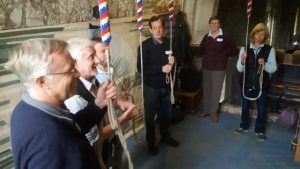
Practical Exercises in the Tower
The first theory part after lunch was ‘Building a Band’. This was an interesting discussion as very often the best ringer in a tower many not be the best manager. The best ringer may be a poor teacher or, indeed, may not want to teach. I could tell from the discussions through the day that often the person in the role of Tower Captain was so entrenched in ‘the way we’ve done it for years’ or their unwillingness to let others run a practice that the issue of ‘Building a Band’ must not be underestimated. I was reminded of a quote in the Hitch-hikers Guide to the Galaxy where it was asserted that “anybody who can get themselves into a position of authority must, on no account, be able to do so”. Just because you have a title does not make you the expert!
Building a band can be viewed from two perspectives 1) it exists so how can it be built on… OR… 2) starting building a band from scratch. I wonder which is worse.
We then returned to the bells to look at various training aids and exercises in moving from called changes to plain hunt. I loved the hand clapping exercises to show the handstroke lead (simple yet obviously useful). A highlight for me was the usefulness of kaleidoscope ringing. I had heard of this a way of getting you to think on your feet, aka ‘catching you out’ while ringing (3 & 4 make places or dodge etc.). I had never thought of using it more constructively to ease the change from ‘ringing by bell number’ towards ‘ringing by bell place’ and I can now see it as a
very useful tool.
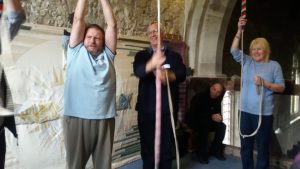
Twinkle Twinkle Little Star – a game for setting practice, at hand and backstroke
The widest topic of the day was ‘the best way to teach plain hunt’. Is ‘by sequence’ best or ‘by place’ and how can you best teach rope sight (or can you?). On reflection I would have liked the training to promote one way to first start rope sight other than by watching by covering. I had heard of the approach of “Rope sight by Rope’s Height” but is this a worthwhile approach and if so what are its rules?
All through the day discussions were had using terms such as ‘teacher’, ‘learner’, ‘student’, improver’ ‘captain’ and ringing master. We need to be clear on what we hope to achieve in ringing with our band with our learners and with each individual ringer. This training suggests ways of approaching the various tasks in a tower such that each attendee feels increasing confidence, increasing ringing performance and can contribute to the band according to their personal strengths. This makes the role of the tower captain far wider than it has historically been viewed. I jokingly say that in my role of Tower Captain only a 1/3rd of it is actually ringing – I thought that I was somehow wrong but perhaps I’m getting the balance about right.
So how is M2F different form M1? Well that depends on your personal ability. I found M1 slightly more concrete in its ‘how to’ whereas M2F seems less prescriptive. In broad brush approach (my perspective) I’d say that if you were more of an engineer than an artist M1 will be easier than M2F and, of course the other way around. Both are very useful depending on your need. I may attend M2C later.
At the time of writing two future M2F courses are listed Swaffham Bulbeck in Cambridgeshire (12/11/16) and Ripon, Yorkshire (19/11/16). I would strongly recommend attending these courses.
Bob Cox, Tower Captain. Walsoken
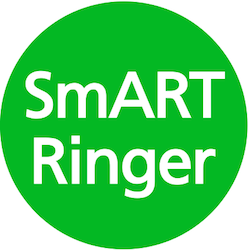

I’m learner rather than a teacher but it is interesting to see what’s in the M2F course as that’s the stage I’m currently at. I have some thoughts about what particular bits of the transition from call changes to plain hunt I’m finding difficult and some suggestions as to how to help with them. Most of the things I’m struggling with I share with the other learners in the tower that are at my stage. Perhaps a blog post is in order 🙂
Sounds good, Alan – please do share your thoughts on here. ART management and tutors are always keen to hear feedback and suggestions from ringers!
PS: Pleased to have it confirmed by Bob that I’m a real person! (not a hired actor!)
Rose